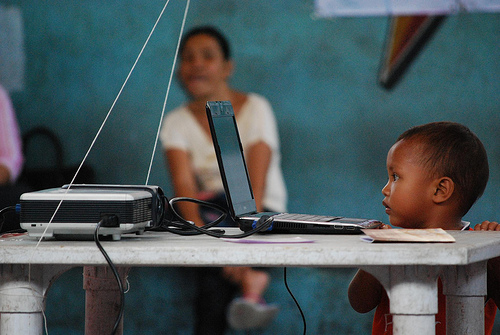Iowa Parent Information Resource Center and reference the PIRC website, www.iowaparents.org.
Summer months are often filled with sports clinics, camps, library reading clubs, trips to the swimming pool and family vacations for
many school-age children. But for some children, summer break means extra time in front of the television or computer screen with
little parental supervision.
And there are other children whose parents would like to help, but they don’t know how or don’t realize the importance of staying academically
stimulated.
Why does it matter?
Students who do little during the summer months to stimulate their minds experience what is known as “summer slide.” This is when
they lose academic skills, mostly in the areas of math and reading, and then experience setbacks when they return to school in the fall.
The setbacks force teachers to spend about four to six weeks at the beginning of the school year refreshing students and bringing them
back to where they were at the end of the previous academic year. For example, students in the Grand Rapids (Michigan) school district
were found to have lost about 40 percent of what they learned from the previous school year, according to a study done between 2003
and 2004.
And the U.S. Department of Education has reported that students’ reading skills fall behind about 25 percent each summer. The average
student also loses about 2.6 months of grade-level equivalency in math computation skills during the summer.
In addition to brain activity, children also need to participate in physical and social activities during the summer to keep their bodies
strong. Much of a child’s social stimulation can be received through interaction and activities with family members.
Also, parents need to help their children prepare for the next grade level during the summer months. This is increasingly important for
those children who will enter kindergarten or the next academic stage such as middle or high school.
What the research shows
Most children experience a slight academic setback during the summer months, according to studies by Johns Hopkins University’s
School of Education. The effect varies widely and is most apparent between low-income students and their middle-class peers.
The university’s National Center for Summer Learning has reported the following:
• Most students lose two months of math skills during the summer. This mostly occurs because parents are able to keep their children
reading during summer months but pay less attention to math, according to Harris Cooper, an education professor at Duke University.
• Low-income students lose reading skills, while middle-class students mostly make slight gains.
• Most of the loss occurs in elementary school, so that by the time some students reach fifth grade, they are academically 2 ½ years
behind their peers.
Other studies have found:
• Students usually score lower on standardized tests at the beginning of the new school year than they did at the end of the previous
school year.
• Many low-income youth who fell behind during the summer months eventually drop out or do not attend college.
• Children also gain weight more rapidly during summer break.
• Parents have reported they have difficulty finding productive activities for their children to do during the summer.
What can parents do?
Arne Duncan, secretary of the U.S. Department of Education, said families need to use the summer months to spend time with their children.
They need to turn off the television and instead visit museums, parks and libraries. Each child should have a library card, and families
should “find ways to continue to learn and to learn as a family all summer,” he said.
Research has shown that summer reading offers one of the greatest benefits because it improves comprehension and vocabulary regardless
of the subject. Reading is most effective when a parent is involved, according to a Harvard University study.
There are numerous activities parents and other adults can do with children regardless of financial status. These ideas include:
• Read: Parents should read to their child every day. Children improve more quickly when an adult asks questions about the material and
makes the child re-read difficult passages. Books are too difficult for a child if he or she does not understand five or more words in a 100-
word section. Also, set an example and make sure the child sees you reading.
• On the road: Play “I Spy” with road signs for numbers, colors and shapes. Ask older children to estimate and calculate the travel time to
a destination.
• Get outdoors: Take children to parks and trails for walks or to ride bicycles, or plant a garden or flowers together. Spend time before the
outing to gather information and ask children about the plants and wildlife they encounter.
• In your city: Take trips to the museum or other cultural amenities during free admission days. Find free or inexpensive camps through
your city’s parks and recreation department, school or other groups.
• At the ballpark: Teach young fans how to calculate statistics such as RBIs or ERA. Suggest that they read a book about baseball before
the game to teach kids more about the sport and to brush up on reading skills.
• Volunteer: Ask a friend or relative to host a child at his or her workplace for a day, or take your child to pick up litter or volunteer at a
soup kitchen or senior center.
• In the kitchen: Allow a child to help out by measuring ingredients and reading recipes. Ask more challenging questions such as how
many pints are in a quart and how to divide ingredients.
• Online: Numerous universities and community colleges offer free online courses, some of which can be downloaded to portable devices.
Websites such as readingrocket.org can give parents reading tips to help their child at various ages.
• Move it: Attend summer music festivals with your children and dance together. Sign up your child for summer swimming lessons or
other athletic events.
• Get prepared: Establish a school-night routine a couple of weeks before school starts that includes earlier bedtimes.
• Be involved: Attend back-to-school and orientation nights to meet teachers, and learn about school and classroom
expectations.
• As a family: Plan and cook meals together, share family traditions/customs, or tell stories and reflect upon fun
times.
• Play games: Tell jokes and riddles and share trivia; also, play board games or other games together. Another way to
get the brain working is to play thinking games such as categorizing items such as animals or foods, and doing word clusters.
• Pen pals: Work as a family to write a letter to another family member or a friend. Everyone should contribute ideas.
• Turn it off: Have at least one full week with no television or video games.
Ideas by grade level to prepare your child for school:
Kindergarten –
1. Help children develop their language skills by teaching them to use adjectives and follow simple directions.
2. Read to your child every day.
3. Sing songs and listen to music.
4. Practice matching letters, rhyming words and organizing things by size, color, shape, etc.
5. Teach your child to do things by themselves such as get dressed, eat, clean up and use the restroom.
Middle school –
1. Show your child how to become organized such as using a different folder for each subject and teach them how to record assignments.
2. Help your child keep track of their activities by having a calendar at home on which events and homework assignments can be written.
3. Create a homework schedule and set aside time each night for reading and writing.
High school –
1. Encourage your child to get a job in order to make him or her more responsible and help understand what it’s like to have a job.
2. Help children prepare for their future by taking challenging classes and creating a plan for after high school.

 AUGUST 12, 2011
AUGUST 12, 2011 


